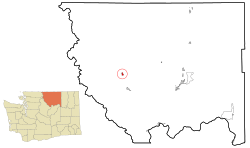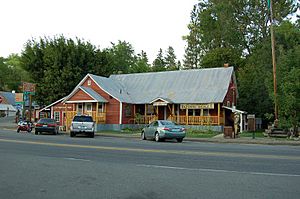Winthrop, Washington facts for kids
Quick facts for kids
Winthrop, Washington
|
|
|---|---|

Downtown Winthrop
|
|

Location of Winthrop, Washington
|
|
| Country | United States |
| State | Washington |
| County | Okanogan |
| Area | |
| • Total | 0.93 sq mi (2.42 km2) |
| • Land | 0.93 sq mi (2.42 km2) |
| • Water | 0.00 sq mi (0.00 km2) |
| Elevation | 1,768 ft (539 m) |
| Population
(2020)
|
|
| • Total | 504 |
| • Density | 542/sq mi (208.3/km2) |
| Time zone | UTC-8 (Pacific (PST)) |
| • Summer (DST) | UTC-7 (PDT) |
| ZIP code |
98862
|
| Area code(s) | 509 |
| FIPS code | 53-79380 |
| GNIS feature ID | 1528259 |
Winthrop is a small town in Okanogan County, Washington, in the United States. It's located east of Mazama and north of Twisp. In 2020, about 504 people lived there. Winthrop is famous for its unique downtown area, which looks like an Old West town from the 1890s! This special style was adopted in 1971, just before a big new highway, the North Cascades Highway, opened.
Contents
History of Winthrop
Early Inhabitants and Explorers
Long ago, Native Americans, like the Methow people, were the first to live in the Winthrop area. They settled along the Methow, Twisp, and Chewuch rivers. Evidence shows people lived here at least 8,000 to 10,000 years ago. They gathered camas roots, picked berries, fished, and hunted. Later, in the 1800s, Fur trappers also visited the valley.
In 1879, the government created the Columbia Reservation for tribes led by Chief Moses. However, this reservation was later opened up for American settlers on May 1, 1886.
Gold Rush and Town Founding
In early 1868, people found gold in the Slate Creek District. This discovery brought the first permanent white settlers to the upper Methow Valley in the 1880s. A settlement was started and named Winthrop, after an adventurer and writer named Theodore Winthrop. The town got its own post office on June 18, 1891.
In 1892, Guy Waring from Boston opened the town's first trading post and general store. He had moved to the area a year before. Waring became the town's postmaster. He tried to rename the town "Waring," but people didn't like the idea. He later started the Methow Trading Company and other businesses. His family lived in a building known as the "Castle," which is now the Shafer Museum.
Growth and Challenges
A big fire in 1893 destroyed much of the town, but it was rebuilt. Guy Waring's original Duck Brand Saloon, built in 1891, survived the fire and is now Winthrop's Town Hall. In 1894, a flood washed away a bridge, which was rebuilt in 1895. At this time, Winthrop's main industries were a sawmill, dairies, cattle ranching, and supplying goods to local mines.
An interesting fact: Owen Wister, who was Guy Waring's friend from Harvard University, wrote The Virginian, America's first Western novel, after visiting Winthrop for his honeymoon.
Protecting the Valley
In 1897, President Grover Cleveland declared Winthrop and the surrounding valley part of the Washington Forest Reserve. This order stopped new settlements and development. However, residents protested because they were already using the land for farming. So, in 1901, the valley was removed from the protected area.
The town of Winthrop was officially mapped out by Waring in 1904. A nearby town called Heckendorn started three years later, but it eventually became part of Winthrop when Winthrop officially became a town on March 12, 1924. By 1915, most of the mines in the area had closed down.
The Old West Makeover
Plans for a road across the North Cascades mountains began in 1893. The section through the Methow Valley and Winthrop was finished in 1909. It was one of the first highways built by the Washington State Department of Highways. This road was paved in 1938.
The last 30 miles (48 km) of the highway through the mountains weren't finished until 1972. To get ready for the many tourists expected from the new highway, Winthrop decided to give its downtown a special look. In 1971, with money from a lumber businessman and local stores, a large project began. A two-block area of downtown was rebuilt to look like an 1890s Old West town, with false fronts on buildings and wooden sidewalks. By September 1972, 22 buildings had been remodeled. A special board was created to make sure all new buildings kept the "Western" style.
Geography and Climate
Location and Landscape
Winthrop is located where the Methow and Chewuch rivers meet, in the beautiful Methow Valley. The town sits at the eastern base of the Cascade Mountains, about 1,760 feet (539 meters) above sea level. The Okanogan–Wenatchee National Forest and the state-managed Methow Wildlife Area surround the valley.
The town covers about 0.94 square miles (2.42 square kilometers) of land. Winthrop also has a lake called Pearrygin Lake, which is a popular spot for swimming.
Winthrop's Climate
Winthrop has a humid continental climate. This means it has cold, snowy winters and very warm summers. Summer nights are cool, and there isn't much rain. Winthrop and Mazama once recorded the coldest temperature ever in Washington state: –48 °F (–44.4 °C) on December 30, 1968. The hottest temperature recorded in Winthrop was 109 °F (42.8 °C) on June 30, 2021. Even in summer, it can sometimes get frosty.
| Climate data for Winthrop, Washington, 1991–2020, extremes 1906–present | |||||||||||||
|---|---|---|---|---|---|---|---|---|---|---|---|---|---|
| Month | Jan | Feb | Mar | Apr | May | Jun | Jul | Aug | Sep | Oct | Nov | Dec | Year |
| Record high °F (°C) | 57 (14) |
62 (17) |
79 (26) |
89 (32) |
100 (38) |
109 (43) |
106 (41) |
105 (41) |
100 (38) |
88 (31) |
68 (20) |
70 (21) |
109 (43) |
| Mean maximum °F (°C) | 43.2 (6.2) |
49.1 (9.5) |
63.4 (17.4) |
75.3 (24.1) |
86.3 (30.2) |
90.6 (32.6) |
97.0 (36.1) |
97.3 (36.3) |
90.2 (32.3) |
76.3 (24.6) |
55.4 (13.0) |
41.4 (5.2) |
98.9 (37.2) |
| Mean daily maximum °F (°C) | 29.9 (−1.2) |
38.4 (3.6) |
50.0 (10.0) |
61.1 (16.2) |
71.1 (21.7) |
76.7 (24.8) |
85.8 (29.9) |
85.6 (29.8) |
77.0 (25.0) |
60.9 (16.1) |
41.2 (5.1) |
29.2 (−1.6) |
58.9 (15.0) |
| Daily mean °F (°C) | 22.6 (−5.2) |
28.2 (−2.1) |
37.7 (3.2) |
46.7 (8.2) |
55.4 (13.0) |
61.3 (16.3) |
68.3 (20.2) |
67.5 (19.7) |
59.1 (15.1) |
46.4 (8.0) |
32.9 (0.5) |
22.3 (−5.4) |
45.7 (7.6) |
| Mean daily minimum °F (°C) | 15.4 (−9.2) |
18.0 (−7.8) |
25.4 (−3.7) |
32.2 (0.1) |
39.7 (4.3) |
45.9 (7.7) |
50.8 (10.4) |
49.3 (9.6) |
41.2 (5.1) |
31.9 (−0.1) |
24.5 (−4.2) |
15.4 (−9.2) |
32.5 (0.3) |
| Mean minimum °F (°C) | −6.7 (−21.5) |
1.3 (−17.1) |
12.4 (−10.9) |
22.9 (−5.1) |
28.2 (−2.1) |
36.7 (2.6) |
42.1 (5.6) |
39.9 (4.4) |
30.3 (−0.9) |
19.5 (−6.9) |
7.9 (−13.4) |
−2.7 (−19.3) |
−10.4 (−23.6) |
| Record low °F (°C) | −32 (−36) |
−28 (−33) |
−11 (−24) |
13 (−11) |
20 (−7) |
28 (−2) |
31 (−1) |
28 (−2) |
18 (−8) |
5 (−15) |
−17 (−27) |
−48 (−44) |
−48 (−44) |
| Average precipitation inches (mm) | 2.06 (52) |
1.28 (33) |
1.23 (31) |
0.84 (21) |
1.13 (29) |
1.09 (28) |
0.69 (18) |
0.45 (11) |
0.45 (11) |
1.37 (35) |
2.03 (52) |
2.57 (65) |
15.19 (386) |
| Average snowfall inches (cm) | 16.6 (42) |
8.8 (22) |
3.4 (8.6) |
0.1 (0.25) |
0.0 (0.0) |
0.0 (0.0) |
0.0 (0.0) |
0.0 (0.0) |
0.0 (0.0) |
1.1 (2.8) |
7.6 (19) |
21.8 (55) |
59.4 (149.65) |
| Average extreme snow depth inches (cm) | 21.7 (55) |
19.8 (50) |
14.1 (36) |
0.3 (0.76) |
0.0 (0.0) |
0.0 (0.0) |
0.0 (0.0) |
0.0 (0.0) |
0.0 (0.0) |
0.8 (2.0) |
5.1 (13) |
15.4 (39) |
23.5 (60) |
| Average precipitation days (≥ 0.01 in) | 12.3 | 8.7 | 7.9 | 6.5 | 7.6 | 7.3 | 4.4 | 3.8 | 4.3 | 8.5 | 12.3 | 13.3 | 96.9 |
| Average snowy days (≥ 0.1 in) | 10.1 | 5.0 | 2.1 | 0.2 | 0.0 | 0.0 | 0.0 | 0.0 | 0.0 | 0.5 | 4.6 | 11.7 | 34.2 |
| Source 1: NOAA | |||||||||||||
| Source 2: National Weather Service | |||||||||||||
Population of Winthrop
| Historical population | |||
|---|---|---|---|
| Census | Pop. | %± | |
| 1930 | 270 | — | |
| 1940 | 365 | 35.2% | |
| 1950 | 396 | 8.5% | |
| 1960 | 359 | −9.3% | |
| 1970 | 371 | 3.3% | |
| 1980 | 413 | 11.3% | |
| 1990 | 302 | −26.9% | |
| 2000 | 349 | 15.6% | |
| 2010 | 394 | 12.9% | |
| 2020 | 504 | 27.9% | |
| Sources: U.S. Decennial Census 2020 Census |
|||
In 2010, Winthrop had 394 people living there. By 2020, the population grew to 504 people. Most of the people living in Winthrop are White (97.5%). A small percentage are Hispanic or Latino (4.3%).
Fun Things to Do in Winthrop
Attractions and Activities
Winthrop is well-known for its unique American Old West style buildings. This makes it a popular place for tourists to visit. The idea for the town's theme was inspired by other themed towns like Leavenworth, Washington.
Winthrop is also a great place for cross-country skiing, with over 120 miles (200 kilometers) of well-kept trails. The town hosts fun events like the Winthrop Rhythm and Blues Festival and the Methow Valley Chamber Music Festival. You can even visit the oldest legal saloon in Washington state here!
See also
 In Spanish: Winthrop (Washington) para niños
In Spanish: Winthrop (Washington) para niños


